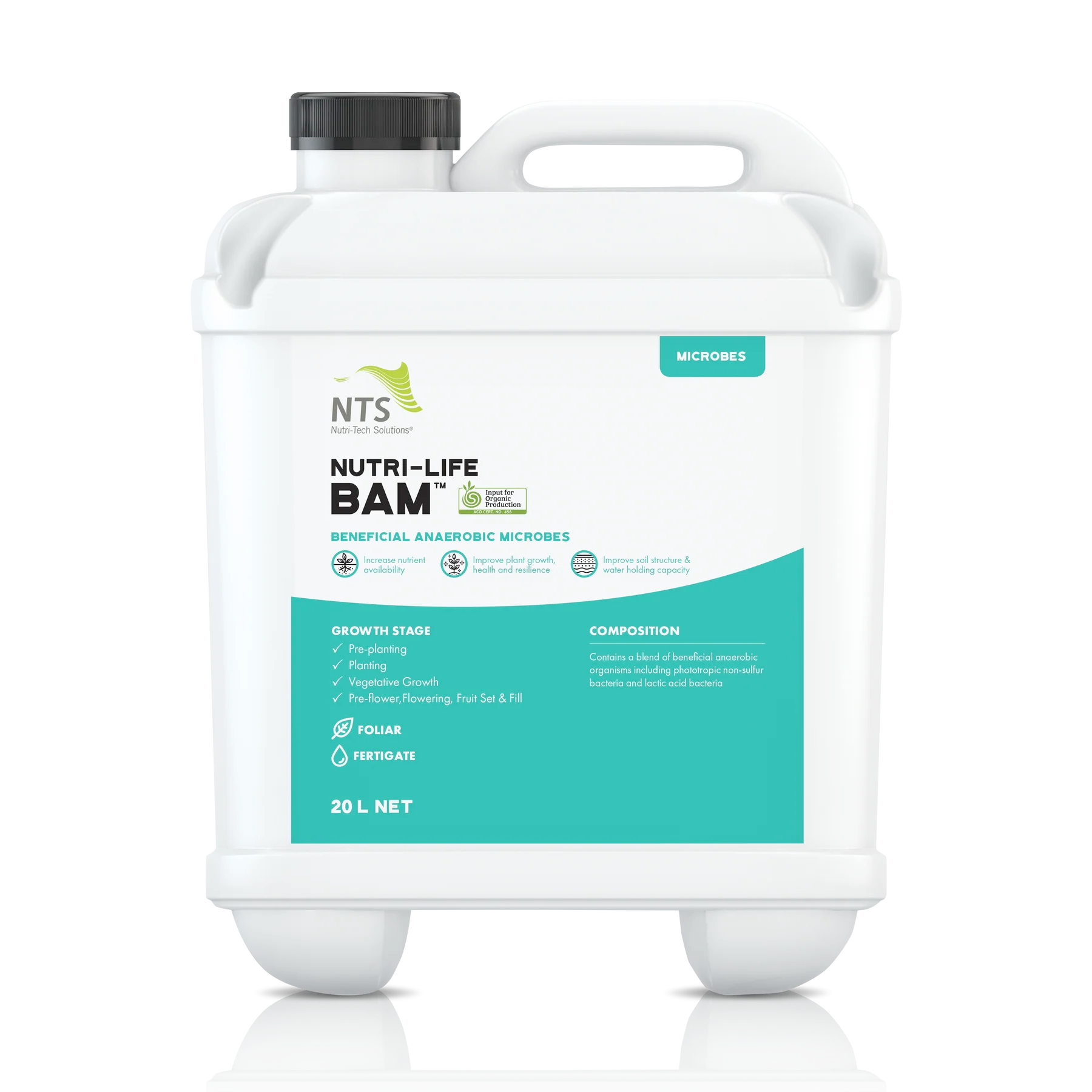Composting Choices - Aerobic vs Anaerobic

Compost is a powerhouse soil improver, and there are few things more satisfying than creating your own. In fact, DIY composting can almost become addictive, due to a host of positive reinforcements. Here, we will discuss the pros and cons of aerobic vs anaerobic composting.
Compost is often seen as a tool to increase organic matter, but this benefit is just one part of a bigger story. Biodiversity is the central driver of natural systems, and it is the vast array of microbes found in compost that can often provide the greatest rewards. We have compromised this desired diversity with chemical, extractive agriculture, and compost helps address our mismanagement.
The introduction of billions of beneficials per teaspoon can effectively reclaim your soil's capacity to build humus from sugar exudates, root residues, and crop stubble. This diversity is also the key to a disease-suppressive soil. This inherent resistance relates to the competition, antagonism, and parasitism introduced with this new workforce.
There are many roads to Rome in terms of composting strategies. These include a variety of aerobic techniques, including intensively managed windrow composting and the slower, but much less intensive, concept of static pile composting. We can also enlist the help of specialist earthworms to fast-track and improve the end result.
This vermicomposting process produces a super-productive compost, but there can sometimes be issues with weed seed and disease carryover due to the lack of a heating stage (the thermophilic phase). This can easily be countered by pre-composting the intended vermicompost raw materials for a couple of weeks before introducing them to the worms.
The Johnson/Su bioreactor utilises an enhanced self-aerating, slow-cooking approach that produces a fungal-dense, proven performer during the 12-month curing period.
However, here we are going to take a closer look at a completely different composting approach that is much more rapid, much less labour-intensive, and far more efficient.
Some conventional microbiologists, striving to build soil-life awareness, have demonised anaerobic organisms. They almost seem to spit on the ground as they describe the rotten egg (hydrogen sulphide) and vomit (butyric acid) smells that can billow from the bowels of tight, closed soils as they struggle for breath. These are plant-toxic substances produced by anaerobic organisms thriving in these conditions. Often, plant pathogens can also favour low-oxygen scenarios, so it is easy to see how all anaerobes might be tarred with the same brush.
However, there are also beneficial anaerobes that can provide most of the benefits of their aerobic counterparts, and there is compelling evidence to suggest that we need to better utilise these inoculants in the soil and in the composting process.
The Dynamics of Anaerobic Composting
Let’s begin by discussing the dynamics of anaerobic composting, and we will also look at some studies confirming the potential of this approach.
It’s important that we understand one thing first. Here, we are talking about 'fermentation' rather than aerobic decomposition. Fermentation must be differentiated from 'putrefaction', which refers to an anaerobic rotting process.
Beneficial anaerobes are now commonly available as inocula (the NTS product, BAM™ (Beneficial Anaerobic Microbes) and the Japanese-developed blend called EM). They consist of multiple strains of Lactobacillus, yeasts, and photosynthetic bacteria, and they also contain good levels of fermenting fungi and actinomycetes.
It’s important to realise that lacto-fermentation is not a new concept. It is how we make silage to improve and preserve the nutrient value of fodder. The daily consumption of lacto-fermented food is also one of the longevity secrets of the vast majority of the longest-living cultures in our world, including the Hunzas, the Georgians, and the Koreans. This relates to a purported five-fold increase in nutrient availability when these foods are microbially enhanced. This living food also provides multiple probiotic benefits.
There are many papers quantifying the value of anaerobic compost. These may be best summarised in a Malaysian review called, “Application of Effective Microorganism (EM) in Food Waste Composting: A Review” by Muttalib, Ismail, and Praveena.
Lactobacillus are found in every soil, in every digestive tract, and on all plant surfaces. Professor Teruo Higa, the founder of EM, simply focused upon why they can be found everywhere, when nothing in nature is accidental. He found that they perform very similar roles to aerobic beneficials. There are those that digest carbon, others that fix nitrogen, and many that enhance mineral uptake. The lactic acid they produce can also be toxic to pathogens.
The yeast component produces multiple amino acids and other bioactive compounds that feed and stimulate other soil organisms.
There is also an important photosynthetic bacteria in these blends that is really quite special.
A recent review of research into these organisms might help you better understand their potential. You can easily conduct an internet search to further inform yourself about this topic. The paper is entitled “Purple Non-Sulphur Bacteria and Plant Production: Benefits for Fertilization, Stress Resistance and the Environment” and is authored by a researcher named Sakarika.
You will get excited when you see the functions of these organisms. They can fix nitrogen, solubilise phosphate, and remediate heavy metals. They can also sequester carbon and lower methane emissions. These organisms can also produce multiple plant growth-promoting substances along with carotenoids and siderophores that provide pest resistance. They also produce copious quantities of vitamins including plant growth stimulants like B2, B6, and B12, along with immune-enhancing vitamins C, E, and D. Finally, these organisms have been shown to increase stress resistance in multiple crops. They really do tick all the boxes, in terms of better managing climate change farming.
The fermenting fungi and actinomycetes found in both EM and BAM™ can obviously help with the breakdown of more fibrous organic matter during the composting process, and when this microbe blend is used to speed stubble digestion.
Importantly, blends of beneficial anaerobes are perfectly suited to help reclaim tight, closed soils that do not favour the aerobes. Nitrogen efficiency, for example, reduces considerably in high magnesium soils. This is because the organisms responsible for converting atmospheric N into ammonium nitrogen in the soil are highly aerobic. They falter in the absence of oxygen, and consequently, high magnesium soils can require 50% more expensive, commercial nitrogen to achieve similar results, compared to a soil that breathes better.
Inocula, like BAM™, can serve as pioneering workforces that can thrive in these oxygen-depleted conditions. They can begin to create the soil aggregates which are essential for improved soil breathing, or gas exchange. This in turn improves the likelihood of the aerobic organisms making a comeback.
Soil microbes, both aerobic and anaerobic, enhance mineral availability. They can release locked-up minerals to make them available to your crop.
The Dangers of Reductionism
Here, there is value in considering the phenomenon of reductionism. The world of regenerative agriculture is overflowing with pundits dumbing down a complex, interrelated system. There are those who claim that microbes are all we need. I have heard absurd claims that this ancient continent has all the minerals we will ever require, and that all we need is the microbial activity to release and deliver that rich mineral load. The reality is that we have many seriously depleted soils, and the Australian agricultural landscape is peppered with those that crashed and burned through adherence to this oversimplified game plan. There are most definitely situations where microbes can mine soil reserves and fix nitrogen, to help create low-input, yield outcomes. However, it is a brave producer who would simply assume that they have an abundance of minerals to mine.
It is critical to monitor your reserves, to determine the state of your mineral bank account. Conventional soil tests roughly measure the minerals that are readily accessible to your crop. They do not measure your reserves. This is the reason that the NTS Agronomy Team will typically suggest that you conduct a complete test, that measures both available minerals and 'total' minerals. The inclusion of a test measuring 'totals' provides a much more accurate insight into your overall mineral status. If your totals reveal serious shortages of phosphorous, zinc and boron, for example, then what do the microbes have to mine?
Here, you will find that a zinc seed treatment, a pre-flower boron foliar, and a urea/humic acid foliar application will deliver substantial yield benefits.
Conversely, we see consultants suggesting that minerals matter over all else. If we correct our calcium to magnesium ratio and adjust a few other core ratios, then it is supposedly all over bar the shouting. However, this is often not the case.
Professor William Albrecht spoke about a three-legged stool, involving the chemical, the physical, and the biological. The 'chemical' aspect involves minerals and their relative balance. The 'physical' aspect involves the associated change in soil structure that improves the inflow of oxygen and the outflow of CO2 (gas exchange). The basis of the Albrecht approach assumes correction of cation balance will improve the soil's capacity to breathe, and then soil life will rejoice. This forms the biological leg of that stool. The reality is that 70 years ago that equation may have worked more often than not. However, seven decades of extractive, chemical agriculture have often decimated soil life. Now, we have often reached a point where this formerly reliable, oxygen trigger no longer guarantees the desired microbial response. This is why we focus equally on minerals, microbes, and humus, as the mainstays of the Nutrition Farming® approach.
Anaerobic vs Aerobic - Relative Efficiency
Typically, in an aerobic composting scenario, one tonne of raw material will produce around 650 kg of actual compost. An anaerobic compost involving EM, BAM™, or a DIY lactobacillus tea can transform that same one tonne of organic matter into 920 kg of compost. That’s a whopping 40% greater humus-building efficiency. Some of the extra weight loss, linked to an actively managed, aerated compost, relates to a loss of carbon as CO₂. Carbon oxidises on contact with oxygen, and constant compost turning produces a flurry of CO₂ that can contribute to the greenhouse blanket trapping heat, and changing our world. Actively managed aerobic composts also release nitrous oxide and methane, but this undesirable outcome is rarely considered. When you open a compost, you also dry it out more rapidly, use much more precious water, and the leachates from this water include leachable minerals like nitrate nitrogen, sulphur, potassium, and boron. Anaerobic composts are covered and sealed, so these negatives are neutralised.

Five Unique Benefits of Anaerobic Composting
Let’s look at 5 other benefits of anaerobic composting:
Heavy Metal Remediation - Beneficial anaerobes can help counter heavy metal contamination. Research demonstrates that these anaerobes can actually utilise heavy metals in their metabolism. This cleansing capacity can remove or transform these toxins, reducing their impact on plant growth and/or animal and human health. This phenomenon can reduce heavy metals in the actual compost or in the soil, following application. In 2013, Saad et al. reported substantially lower concentrations of heavy metals in compost produced with EM, compared to conventional aerobic composting. In 2014, Dheeba et al. showed that EM compost applied to a chromium-contaminated soil resulted in crops with greatly reduced concentration of chromium accumulation in roots and shoots. The authors of that study concluded that EM can boost crop resilience against heavy metals.
Rapid Composting - Compost with beneficial anaerobes is fast-tracked with less energy and moisture requirements. There is no diesel needed for the compost turner, and the pile rarely needs extra water. Depending upon the carbon to nitrogen ratio, the BAM compost is typically complete within 8 weeks. In a high nitrogen situation, involving manure or food waste, this timeframe can be reduced to as little as 6 weeks. This compares to 12 weeks for actively managed, aerated compost and 24 weeks for static pile composting.
Increased Carbon and Nutrients - This form of anaerobic composting results in a more nutrient-dense and more carbon-rich end product. Part of this story relates to less leaching and volatilisation of minerals like sulphur, and nitrogen, and the increased carbon relates to CO2 losses associated with constant turning of windrow composts. However, something else is happening here. A 2013 study, by Saravanan et al., showed that EM compost contained more nutrition. There was substantially more nitrogen and phosphorous, but there was 55% more potassium in the EM compost. That’s no small benefit, considering the escalating price of NPK.
More Microbes - This compost can also contain greater microbial activity, and this can be measured on a microbiometer, by monitoring total microbial biomass. There are several studies confirming greater enzyme production, associated with this increased action of microbes. This microbial workforce often outperforms aerobic compost in field trials with increased plant health and yields.
Finally, composting with beneficial anaerobes offers a low-cost, low-energy, smell-free composting option.
Note: The only downside is that you need to source tarps or silage covers to seal the compost heap.
Making BAM™ Compost
It’s a remarkably simple process to make your own anaerobic compost.
First, you will alternate your 30 cm layers of carbon and nitrogen (i.e., hay, or wood mulch (the carbon layer) and manure or green material – the nitrogen layer). It is like making a layer cake.
Next, you apply brewed BAM™ at 5 litres per cubic metre to each layer, and water it in to ensure that each layer is thoroughly wetted down.
Then, you mix up your layer cake with a bobcat, front loader, or tractor bucket, before covering it with a large sheet of plastic or a silage cover.
Next, you batten down this cover with tyres, concrete blocks, or timber and then, 8 weeks later, you remove the cover to reveal delicious, super productive, black compost.
Note: There is a way you can further fast-track this composting process. I have not tried it on my farms, but apparently, if you open the covers and turn the pile at two weeks in, and repeat this again after three weeks, the composting time can be reduced to just five weeks. I guess I should also include the revised recipe for multiplying BAM™, to significantly reduce the cost of the inoculum. Recently, we conducted some DNA analysis to compare brewing recipes. We discovered that the inclusion of a more diverse food source increases the diversity of the end-brew.
Here is the revised 1,000-litre BAM recipe
What you will need:
– 100 litres of BAM™ concentrate
– 20 litres of SeaChange KFF™
– 10 litres of Aloe Tech™
– 40 litres of molasses
A clean 1,000-litre Tank (IBC)
A one-metre length of garden hose
A 2-litre plastic bottle (eg. a large Coke bottle)
Preparation
- Make sure the IBC is clean with no chemical residues, etc. This is really important when multiplying living creatures. A food-grade IBC is ideal.
- Drill a 12 mm hole in the top of the tank. Take a one-metre length of standard, 12 mm garden hose and poke one end through the hole, into the empty space at the top of the tank.
- Attach a two-litre plastic bottle filled with water to the metal frame, two-thirds of the way up the outside of the tank, using plastic ties or wire.
- Now, half-fill a 1,000-litre shuttle (IBC) with water, before adding 100 litres of BAM™, 40 litres of molasses, 20 litres of SeaChange KFF™, and 10 litres of Aloe-Tech™
Note: We typically dissolve the molasses with 50/50 water in twenty-litre drums with a hose, before adding it to the tank, so that it doesn’t clump, undissolved, in the tank bottom.
- It is always a good idea to pre-position the IBC on concrete blocks, high enough to gain access with a 20-litre bucket under the tap at the bottom.
- Now, fill the tank with water and screw on the lid.
- Place the other end of the metre-long length of this hose, deep into the plastic bottle.
- The bottle will bubble as the BAM™ brews. When it stops bubbling, the brew is complete.
Alternatively, you can monitor pH. When the brew reaches pH 3.5, it is complete and will stay stable for up to 2 years.
In Conclusion
Hopefully, you are now suitably motivated to try your own BAM™ compost, or perhaps, you might choose to brew your own living fertiliser. Your BAM™ brew can be combined with any input, and it provides a wonderful response with very low input costs.
